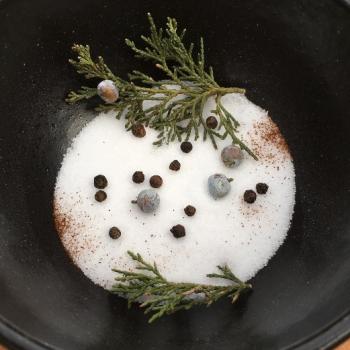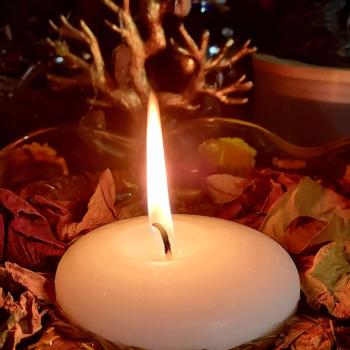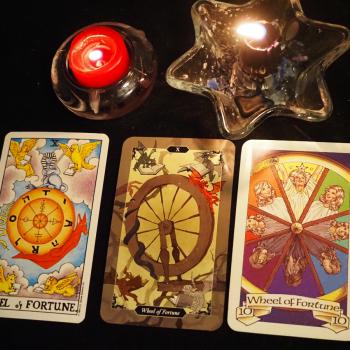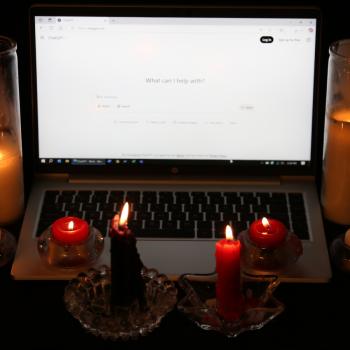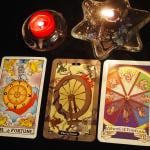 I’ve always loved ritual. The opportunity to compose, lead, and participate in ritual is one of my favorite things about being Pagan. So it’s no surprise I write about ritual a lot – here are some of my favorite pieces:
I’ve always loved ritual. The opportunity to compose, lead, and participate in ritual is one of my favorite things about being Pagan. So it’s no surprise I write about ritual a lot – here are some of my favorite pieces:
Common Ritual Errors and How to Avoid Them
The Challenges of Large Public Rituals
Last week I saw a request for help on a child naming ceremony. Then earlier this week I responded to a Facebook request for suggestions on composing a ritual for a CUUPS group to mark its passage through some difficult times and to recommit themselves to their community and their values. And it occurred to me that most of what’s out there on ritual composition deals with seasonal rites of worship and celebration. There’s not much on rituals for special occasions. I have this piece on Composing Initiation Rituals, but that’s about it.
Much of what makes a Beltane ritual successful is also important in rituals for special occasions: good planning, good writing, good presentation, and a beginning-to-end focus on why you’re doing what you’re doing and what you want people to take away from the ritual. Using a standard liturgy / order of service creates familiarity and helps connect the special event with the core of the tradition. If you can write a good Beltane ritual you can write a good child naming or handfasting or group dedication ritual.
But there are differences, and creating the best special rituals requires paying close attention to those differences.
Special rituals are special. There are eight high days in the modern Pagan year – presumably you’re celebrating them all. If you’re an ethnic reconstructionist you’ve got your own set of holy days. There are 12 or 13 full moons and 12 or 13 new moons in a year. But if you’re a typical coven or grove or CUUPS group, you may get a request for a child naming ceremony once a year. You may have a Chief Druid installation once every three years. You may have a priesthood formation or a temple dedication once in your life.
These rituals are sacred because of what they celebrate and what they attempt to accomplish, but they are special because they are rare. Allow plenty of time to research, write, edit, and rehearse.
And while your usual liturgy is a good starting point, understand your liturgy was likely developed for rituals with different intent. Don’t be afraid to change it. A child naming ceremony involves very small children – keep it short. If that means you can’t do all the preliminary ritual you usually do, so be it.
It’s a special occasion – break the rules. Just break them mindfully.
Know who you’re doing the ritual for. A funeral helps the deceased to move on to the Otherworld, but it also helps the survivors accept that their loved one has moved from the realm of the living to the realm of the ancestors. A child naming ritual is a magical act that gives a child a name, but it also reinforces to the gathered community that “we have a new life in our midst.”
Or to use a very different example, a coronation invests a new king with all the powers of the monarchy, but it also tells the citizens – and the enemies – of the realm “our new king is strong and powerful and so is our nation.” A good ritual speaks to all involved.
If you’re doing a healing ritual, it’s about the person you’re trying to heal and any other concern is secondary. If you were doing a healing ritual for me, I’d want it done in private so I could be open to whatever happened, and so no one would be worried that ecstatic experiences might be misinterpreted. Someone else might prefer an open ritual to add more people to the power of the working.
When you have to choose, choose mindfully.
Know what a ritual can and can’t do. A coming of age ceremony is supposed to mark the passage of a child into adulthood. But how adult-like is a 13-year-old going to feel after the ceremony when she still can’t drive, drink, or vote… and when no one outside the coven is going to treat her any differently than before?
However, a coming of age ceremony can mark a young person’s advance into the liminal zone of adolescence and highlight its opportunities and dangers (including the biggest danger of adolescence – getting stuck there).
No ritual can create perfect love and perfect trust out of egotism and strife. But a good ritual can help wash away old ills and build on a core of good will and common purpose.
No ritual is going to heal the Earth. But a good ritual can energize a few committed people to live in greater harmony with the Earth.
Think big, think magically, and think divinely, but be realistic as well.
Know your foundation. What are you building on? What are the common values and shared experiences? Small local groups that are part of a well-defined tradition (say, Alexandrian Wiccan covens or ADF Druid groves) will have considerable commonalities. Eclectic groups will have to look deeper for common values or just a common purpose for the ritual. Use these to build on and don’t assume everyone’s in agreement when they’re not – founding a CUUPS group around the worship of, say, Hecate is not going to work.
Look at how others have done similar things. Whatever you’re trying to do with ritual, someone else has done something like it – and they’ve probably put it on the internet for you to find. There’s a bazillion wedding, child naming, and funeral rituals out there. There are rites of initiation, ordination, and installation.
Some of them are Christian or Jewish or even secular, but that doesn’t mean they’re useless to Pagans. If you’re a good ritualist, you can deconstruct them, borrow what works well and ignore the rest.
Just remember John’s rules of cultural appropriation: credit your sources and don’t pretend to be something you aren’t. In Sam Webster’s words, “tech is transferrable, culture is not.” Other than that, steal from the best.
Draw on myths relevant to your situation. “OK, but what are we going to do?” Getting the structure right is critical but it’s relatively easy. The hard part is figuring out what content to plug into that structure.
One of the definitions of ritual is “embodied myth.” Find a myth that resonates with your situation and tell it, act it out, or ritualize it. For a group unity ritual, you could use the Knights of the Round Table. For the beginning of a project you could use one of the many questing myths – though I’d prefer the story of the rescue of Mabon to the search for the Holy Grail. Kristoffer Hughes’ From the Cauldron Born uses the story of Cerridwen and Taliesin to show just how much can be done with a myth.
The best time to learn myths is now, before you need to ritualize them.
The same, only different. At their core, rituals for special occasions are just like the rituals we perform all the time. They have a goal and a set of actions to achieve that goal. They have an opening, a main working, and a closing. They require preparation, rehearsal, and presentation.
But they have significant differences: infrequent usage, unusual goals, unfamiliar audiences. Think about what’s different and adjust your plans accordingly.
May your rites be powerful and blessed!





